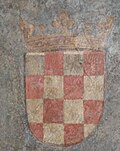Croatian checkerboard

The Croatian checkerboard or chequy (Croatian: šahovnica [ʃaxǒːʋnit͡sa])[1] is the national symbol of Croatia.[2] It is the main shield of the Croatian coat of arms. On top of the main shield is the crown with five smaller shields, each representing a region of Croatia. The squares in the šahovnica are always arranged the right way, colored red and white. Historically, the order varied.
Origin
There is a legend, probably from the 19th century, which talks about how the Croatian king Držislav, captured by the Venetians, played a chess match. His opponent was Doge Pietro II Orseolo. He won and became free, and in some versions of the story he also got power over the Dalmatian cities. Then he put the chessboard in his coat of arms.[3][4]
It first came into use in Croatian coat of arms around year 1495, as depicted on a temple hall located in Innsbruck, Austria. There is likelyhood that it has been borrowed by the House of Habsburg (who ruled the Hungarian-Croatian throne at the time) from other West Slavic coats of arms, as the silver-red colored pattern was popular among the 12–14th century Polish and Czech noble families. The cheque pattern in European heraldry was likely inspired by the board game of chess.
It is considered as the national symbol of Croatia, and is prominently displayed at sporting events. As such, the pattern in these colors remains associated mostly with the nation of Croatia.
Gallery
The Croatian chequy on a church in Baška
The coat of arms of Croatia, used in 1527 as part of a seal on the Cetingrad Charter.
Coat of arms of the Kingdom of Croatia (1525-1868).
Coat of arms of the Croatian Crown land (until 1868)
Coat of arms of the Kingdom of Croatia-Slavonia (1868–1918).
Coat of arms of Transleithania (1868-1915).
Patriotic badge from 1914
Banovina of Croatia (1939–1943).
Independent State of Croatia (1941–1945).
Socialist Republic of Croatia (1947–1990).
Early coat of arms of the Republic of Croatia (1990).
Coat of arms of Croatia proper
Croatian Checkerboard Media
A Croatian Air Force MiG-21 UMD is painted in a red-white Croatian checkerboard.
References
- ↑ "šahovnica - Hrvatski jezični portal - Znanje". Retrieved 20 July 2017.
- ↑ "GRBOVI I DRESOVI EURA Kako je šahovnica postala simbol Hrvatske". Archived from the original on 23 July 2017. Retrieved 20 July 2017.
- ↑ "Legenda o nastanku hrvatskog grba - mojapovijest.com". Archived from the original on 1 October 2020. Retrieved 20 July 2017.
- ↑ "Legende o hrvatskom grbu - Povijest.hr". Retrieved 20 July 2017.
















